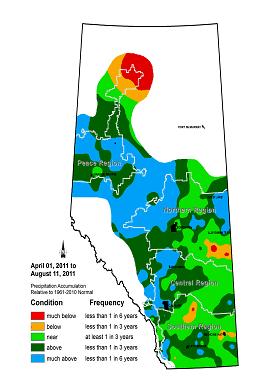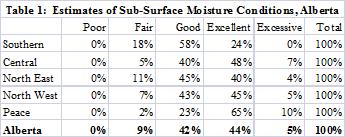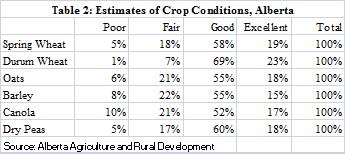| | Overall, crop development is about a week to ten days behind normal. However, early indications suggest provincial average crop yields for major crops could be mostly above average this year. Provincially, spring wheat conditions are rated as five per cent poor, 18 per cent fair, 58 per cent good and 19 per cent excellent. Canola crops are reported as 69 per cent in good to excellent condition and 31 per cent in poor to fair condition (see Table 2). Specialty crops are largely in good to excellent condition. Warm, dry weather is going to be necessary for crops to mature prior to harvest.
.
Throughout the province, during the 2011 growing season (April 1 to August 11), precipitation accumulation has largely been near to above average in most areas. The northern Peace, along with pockets of the North East and Southern Regions has been below average. Over the past two weeks, rainfall has been varied across the province. Overall, soil moisture reserves are rated as being fair to excessive. Table 1 below presents estimates of sub-surface moisture conditions for the province, by region. In terms of surface moisture, there are reports of areas with excessive amounts in all regions, with the Peace Region reporting 22 per cent of crop land being excessively wet. The North East and North West Regions are reporting 12 and 11 per cent respectively. Over the past two weeks there were some scattered hailstorms occurring in all Regions, with localized storms causing some damage.
First cut haying operations in the province vary in terms of progress and quality. In the Southern Region, virtually all of first cut dryland and irrigated haying operations are complete, with above average yields and good to excellent quality. The North East and North West Regions are mostly poor to fair in quality, with completion at 47 and 55 per cent respectively. Haying operations in the Peace Region have progressed up to 65 per cent complete with varying quality, while the Central Region is 81 per cent complete, with good yields and good to excellent quality. A small amount of second cut hay is complete in the Southern Region.
Provincially, pasture growth is rated as two per cent poor, 13 per cent fair, 50 per cent good, and 35 per cent excellent. Tame hay growth is reported at 83 per cent in good to excellent condition. There are reports of problems with lygus bugs in the Southern and Peace Regions. Also, there are some grasshopper issues in the Peace.
 

Our thanks to Alberta Agricultural Fieldmen, staff of AFSC and the Alberta
Ag-Info Centre for their partnership and contribution to the Alberta Crop
Reporting Program.
The precipitation map is compiled by Alberta Agriculture and Rural Development,
Environmental Stewardship Division, Technology and Innovation Branch.
Regional Assessments:
The 2011 Alberta Crop Report Series continues to provide summaries for the following five regions:
Region One: Southern (Strathmore, Lethbridge, Medicine Hat, Foremost)
- Weather conditions over the past two weeks have been mainly favorable for crop development, although there were some isolated reports of hail. The region received some rainfall, mostly ranging from 1 to 20 mm. Also, there were some isolated pockets receiving less than 1 mm or 20-40 mm. Moisture reserves are generally fair to excellent, with a minimal amount being excessive. Additionally, there have been some reports of spraying for lygus bugs.
- Crops are progressing well, with over 85 per cent of spring cereals and 82 per cent of canola in good to excellent condition. Estimated yields for most major crops are above their respective long-term averages.
- Producers have nearly completed their first cut haying operations. Reports indicate relatively strong yields with mostly good to excellent quality for both dryland and irrigated hay. Second cut operations for irrigated hay are also underway. Pasture growth is largely in good to excellent condition.
Region Two: Central (Rimbey, Airdrie, Coronation, Oyen)
- During the past two weeks, most areas of the region received rainfall, ranging from 5 to 50 mm. However a portion of the northwest area received between 80-90 mm. There have been some hail storms which caused some crop damage. Moisture reserves are mostly good to excellent, with a few areas having an excessive amount.
- Despite the recent precipitation and hail, crops are generally rated as good to excellent, as some warmer weather has spurred development. Among major crops, over 95 per cent of spring wheat, canola, oats and dry peas are in good to excellent condition. Early yield estimates are mostly above average.
- Haying is still progressing, now estimated at 81 per cent complete, but rain showers have impacted quality. Pasture is largely rated as good to excellent.
Region Three: North East (Smoky Lake, Vermilion, Camrose, Provost)
- Precipitation during the past two weeks has ranged from 10 to 60 mm in most areas of the region. In the northern portion of the region, crops are maturing relatively slowly as a result of the high moisture and lack of heat. There are also reports of excessive surface moisture in some areas of the region.
- Overall, crops are progressing, but remain behind normal in terms of development. About 70 per cent of spring cereals and 68 per cent of canola are in good to excellent condition. Yield estimates are mostly above average.
- First cut hay operations are still delayed due to wet weather with only 47 per cent complete. Hay quality is mostly ranging from poor to good; however tame hay and pasture conditions generally range from fair to excellent.
Region Four: North West (Barrhead, Edmonton, Leduc, Drayton Valley, Athabasca)
- The region received precipitation over 10 mm, and as high as 60 to 70 mm in an isolated pocket. There have also been some reports of hail storms causing damage to crops.
- Cool and wet weather conditions throughout most of the region have continued to slow crop growth. Spring wheat is reported at eight per cent poor, 29 per cent fair, 55 per cent good, and eight per cent excellent, while canola is 18 per cent poor, 43 per cent fair, 36 per cent good and three per cent excellent. However, estimated yields are generally close to their respective long term averages for major crops such as spring wheat, barley, and canola.
- Rainfall has continued to delay first cut haying operations, with 55 per cent complete and quality mainly ranging from poor to good. Tame hay and pasture conditions vary from fair to excellent.
Five: Peace River (Fairview, Falher, Grande Prairie, Valleyview)
- Over the past two weeks, the region has received below 20 mm of precipitation in most areas, along with much needed hot and sunny weather. While this is an improvement, there are still some areas which have experienced crop damage due to excessive surface moisture and hail.
- Overall, spring wheat is rated as 11 per cent poor, 25 per cent fair, 41 per cent good, and 23 per cent excellent, while canola is reported as 19 per cent poor, 25 per cent fair, 37 per cent good and 19 per cent excellent. Estimated yields are generally around their respective long-term averages. Grasshoppers and lygus bugs are a moderate to severe problem in the northern and western parts of the region.
- First cut haying operations are still behind normal with 65 per cent complete. Hay quality ranges from poor to excellent, with the majority reported as good or excellent. Tame hay and pasture growth is largely rated as good to excellent.
Alberta Agriculture and Rural Development
Economics and Competitiveness Division
Statistics and Data Development Branch
August 16, 2011 | Roy Larsen, Senior Statistician
E-mail: roy.larsen@gov.ab.ca
Phone: 780-644-1308 |
Note to Users: The contents of this document may not be used or reproduced without properly accrediting Alberta Agriculture and Rural Development, Economics and Competitiveness Division, Statistics and Data Development Branch.
The 2011 Alberta crop reporting series is available on the Internet at: http://www1.agric.gov.ab.ca/$department/deptdocs.nsf/all/sdd4191
|
|